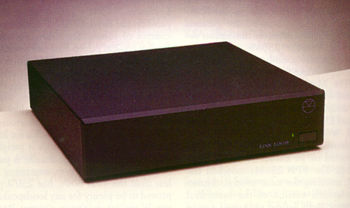| Columns Retired Columns & Blogs |
Linn Linto phono preamplifier
Audiophiles with budget restrictions (most of us, I imagine) could be forgiven for feeling we're afterthoughts to most manufacturers. Even though we probably keep many companies in business by buying their "entry-" or mid-level products, we're always hearing about products designed "without compromise." Waiter, could you bring the reality check, please?
Even if you design a component without regard to the price tag, you still run into the compromises dictated by material science, or our collective ignorance, or even market pressures. (Although, with Asian economies in serious trouble, I'm betting we won't be hearing many manufacturers explaining "We just had to have a product that cost more than our old top-of-the-line in order to be taken seriously.'')

The $1500 Linn Linto and $1200 AcousTech PH-1 phono preamplifiers are both reasonably priced by current analog standards, but neither product comes with an attitude of "This is the best we could do for so little money." Quite the reverse: The Linn commemorates the 25th anniversary of the LP12, while the PH-1 is a love letter to analog posted by Acoustic Sounds' Chad Kassem and high-end designer Ron Sutherland. Both are serious high-end products that make no excuses. Or need to.
Linn Linto
No single company has had a greater impact on analog sound than Linn. In fact, it could be argued that the entire category of high-end turntables owes its existence to the LP12. But Linn has also been a force in tonearm evolution and cartridge development, and now, it could be argued, in phono preamplification. The Linto direct-coupled "Precision" phono preamp is a third-generation circuit that traces its lineage back to Linn's experiments with their own disc-cutting lathe in the early '80s. As the company improved their mastering chain, they found they could no longer measure the lathe noise on the disc—the residual noise from the phono preamplifier was greater than the cutter noise. Linn developed their own phono preamp as a measurement tool, later incorporating it into the LK-1 preamplifier.
The Linto couples the signal from the cartridge directly into the bases of the transistors rather than into resistors or loading networks—because, Linn maintains, these elements waste valuable signal power and generate more signal and noise than the cartridge.
The power supply is another area that can generate substantial amounts of noise in conventional designs. Rather than using a sizable transformer and multiple capacitors in the power supply, the Linto breaks from tradition by employing Linn's Brilliant Switch-mode Power Supply. This converts incoming power into high-voltage DC, then "chops it up at a high frequency" (to quote from the owner's manual) before routing it to a 30mm-square transformer. This transformer's output is converted back to "very smooth" DC voltage.
Open the Linto and you'll see a lot of nothing. Most of the box is empty: A board connected to the mains module carries the Brilliant PS, which is shielded; and a partially shielded circuit board stuffed with surface-mount components is crammed into the opposite diagonal corner—as far away from the supply as it can get. Other than wires connecting the Brilliant to the mains fuses and the power switch on the front, there's nothing else in there.
- Log in or register to post comments




































